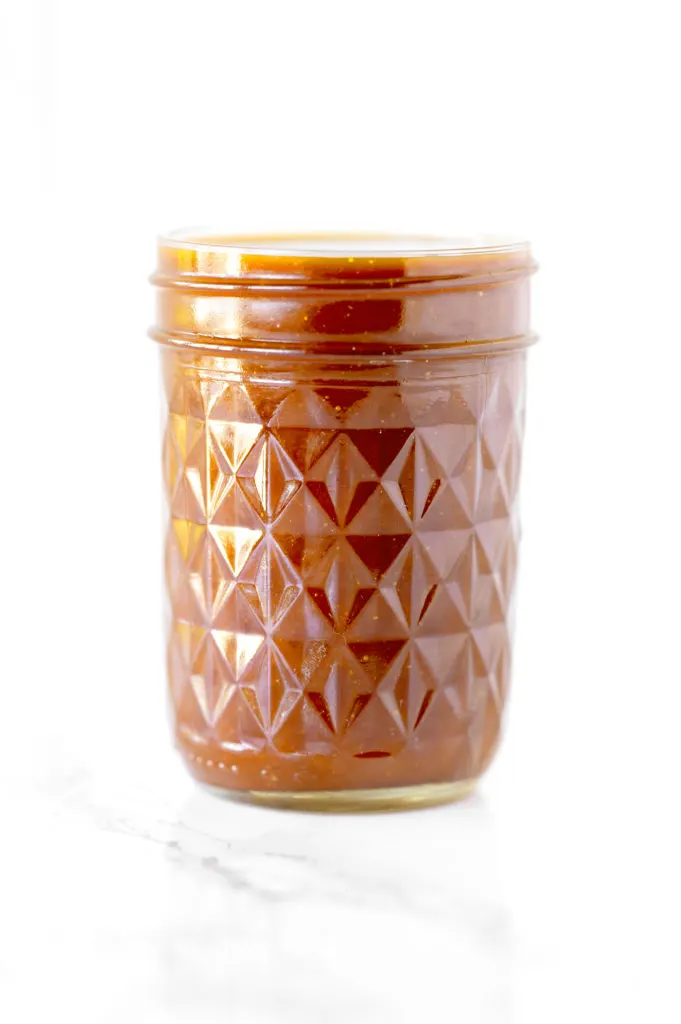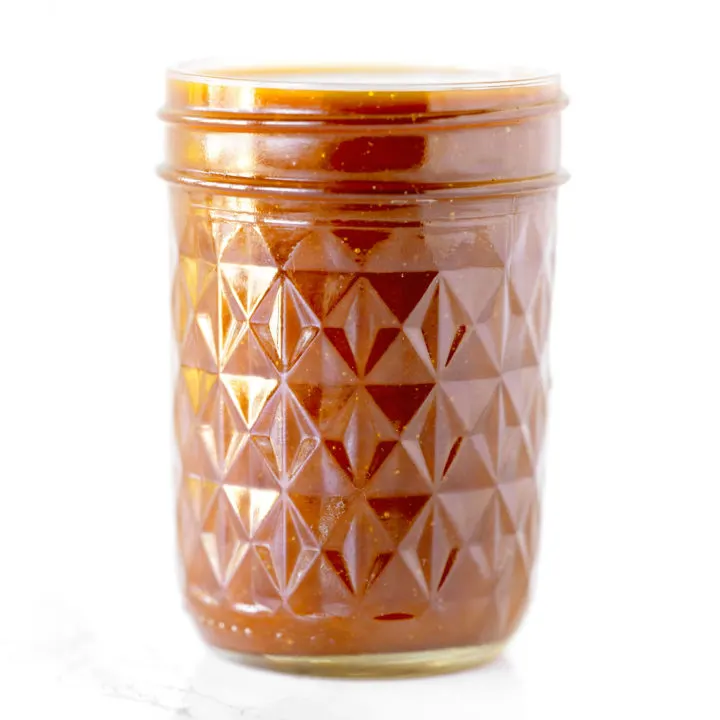This dairy free caramel sauce is easy to make and is oh so yummy. You can also turn it into dairy free salted caramel by using half a tablespoon of salt.

This caramel sauce is wonderful drizzled on top of dairy free ice cream, dairy free apple pie, or dairy free brownies.
Sugar
The primary role of sugar is to be a sweetener. However, sugar also contributes to the tenderness and moistness of the baked good by absorbing and retaining moisture and helps create the golden brown color when baking as it caramelizes.
Recipes with more sugar often result in softer, moister textures. However, I learned the hard way that too much sugar leads to a sticky mess.
When it's heated, sugar caramelizes, resulting in a rich, complex flavor and a brown color. This adds both flavor and color to baked goods and is also the process in which caramel sauce, dulce de leche, caramel candies, and regular candies are made.
When used in recipes containing yeast, the sugar is eaten by the yeast, producing carbon dioxide and causing the dough to rise.
Sugar also acts as a preservative in jams, jellies, and fruit preserves by reducing water activity and preventing microbial growth.
There are many different types of sugar, including white sugar, brown sugar, vanilla sugar, powdered sugar, turbinado sugar, and demerara sugar.
When a recipe calls for “sugar” without specifying anything else, it's referring to regular white sugar.
White Sugar
White sugar (sometimes called granulated sugar, table sugar, or white granulated sugar) is made of either beet sugar or cane sugar, which has undergone a refining process.
It is the easiest to find and most commonly used.
Brown Sugar
Brown sugar is white sugar with molasses added to it.
It is commonly used in chocolate chip cookie recipes, and it’s rare for a recipe that calls for brown sugar not to also call for white sugar as well.
When a recipe calls for “brown sugar” but doesn’t specify what type (light or dark), it is referring to light brown sugar.
In my recipes, you can use whatever type of brown sugar you have on hand, whether it is dark brown sugar, light brown sugar, or demerara sugar - which is very common in Israel.
Just keep in mind that the flavor and color will be slightly different, depending on what you choose to use.
Turbinado Sugar
Turbinado sugar is better known as "raw sugar." But, despite this name, the sugar is not really “raw.”
Instead, it's partially refined sugar that retains some of the original molasses.
The term "raw sugar" may also give off the impression that it is somehow healthier.
In reality, turbinado sugar is nutritionally similar to white sugar.
Demerara Sugar
Demerara sugar is very popular in Israel and is especially delicious in tea, but is also used for baking.
Unlike white sugar, demerara sugar undergoes minimal processing and retains some vitamins and minerals.
However, it is still not much healthier than white sugar.
Vanilla Sugar
Vanilla sugar is not very common in the States. However, it is common in Israel and parts of Europe.
This is sugar that sat for an extended period of time with vanilla beans, giving it a vanilla flavor.
Caster Sugar
This type of sugar is common in the United Kingdom.
It has a grain finer than white (granulated) sugar and larger than powdered sugar.
Caster sugar is often called for in recipes for delicate baked goods like meringues, souffles, and sponge cakes.
You can use a 1:1 conversion rate between caster sugar and white (granulated) sugar.
Powdered sugar
Powdered sugar, sometimes known as confectioners’ sugar, is a sugar with a powdered texture.
This sugar is rarely used for baking. Instead, it is used for dusting desserts and making frosting, icing, and glazes.
In some countries, you can also find powdered vanilla sugar.
It is made the exact same way regular vanilla sugar is made. However, the sugar used is powdered instead of granulated.
Vanilla Extract vs Vanilla sugar
In my recipes, I don’t specify what kind of vanilla to use.
The reason for this is that in the States, vanilla extract is exclusively used.
Meanwhile in Israel, along with many European countries, vanilla sugar is common.
In most, if not all recipes, both vanilla extract and vanilla sugar can be used.
In recipes where vanilla sugar can be used instead of extract, you can replace them 1:1.
Replacing Sugar with Honey
If you’d prefer to use honey instead of sugar, you can do so with pretty good results.
Honey can be two or even three times as sweet depending on the honey, so for every 1 cup of sugar, you can use ½ to ⅔ cup honey.
Since honey adds liquid, you need to remove some to balance it out. For every cup of honey, remove a ¼ cup of liquid.
Also, it burns faster than granulated sugar, so you want to lower the baking temperature by 25 F. In addition, check it early and often to avoid burning or overbaking.
How to Store Sugar
Sugar should be stored in an airtight container to prevent clumping and moisture absorption, and kept in a cool, dry place.
Do I need a Candy Thermometer?
You don’t need one, but if you have a thermometer and want to be very precise, the target temperature is between 338°F or 170°C and 350°F or 176°C.
Above 350°F or 176°C, it’ll start to smell burnt and the sauce will taste bitter. And below 338°F or 170°C, and it you won’t caramelize or have the right color.
Don't over Stir
If you stir the sugar and water as they are heating, you’ll cause grains to form and it will not be smooth and creamy.
Instead, you can gently swirl the pan over the heat if needed. But make sure not to let the caramel go high up the sides of the pot because this will also make the caramel sauce crystallize and become grainy.
What if my sauce crystallizes?
Add a ¼ cup of water and bring the sugar back to a gentle bubble. Heating it up with the water should dissolve the crystals.
Then continue following the recipe until you get color on the sugar.
Can I use this caramel sauce for caramel apples?
This caramel is not thick enough to coat apples for caramel apples.
How to Store dairy free caramel Sauce
After the caramel cools down, you’ll pour it into a lidded glass jar or container.
Store in the refrigerator, tightly sealed, up to 3 weeks.
Caramel solidifies in the refrigerator so it needs to be reheated, either on the stove or in the microwave, until desired consistency is reached.
But reheating the caramel will make it thinner and runnier, and if you let it cool down again it should thicken back up.
How to freeze dairy free caramel sauce
After the caramel cools down, you’ll pour it into a lidded glass jar or container.
Freezer for up to 2 months. After that, it is still safe to eat, but the quality begins to degrade.
Thaw in the refrigerator or at room temperature, before using.
Dairy Free Caramel Sauce

This dairy free caramel sauce is easy to make and is oh so yummy. You can also turn it into dairy free salted caramel by using half a tablespoon of salt.
Ingredients
- 1 cup granulated sugar
- ¼ cup water
- 6 tablespoons unsalted vegan butter, cubed
- ½ cup coconut cream
- 1 teaspoon vanilla
- Pinch of salt*
Instructions
- Add the sugar and water to a 3-quart heavy bottomed saucepan; stir a little so it sits in a flat, even layer.
- Warm over medium heat and bring to a bubble while whisking occasionally and brush down the sides as needed. Continue cooking until the mixture thickens and turns a deep amber color similar to honey (8-12 minutes).
- Add the vegan butter and whisk until completely melted. (The caramel will bubble up rapidly, so be careful and continue to whisk.)
- Remove the saucepan from the heat and slowly pour in the coconut cream, whisking continuously until well incorporated.
- Mix in the vanilla and salt.
- Set aside to cool in the pan for 10 minutes.
- Then pour into a lidded glass jar and allow to cool completely. It will thicken as it cools.
Notes
*For salted caramel use ½ a tablespoon of salt
Nutrition Information:
Yield:
10Serving Size:
1Amount Per Serving: Calories: 193Total Fat: 9gSaturated Fat: 4gTrans Fat: 1gUnsaturated Fat: 6gCholesterol: 0mgSodium: 19mgCarbohydrates: 28gFiber: 0gSugar: 28gProtein: 0g